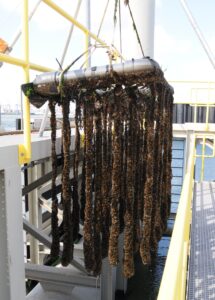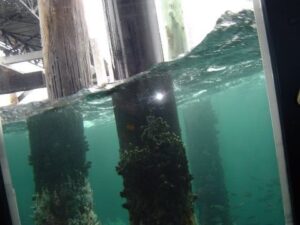Overview
Location: Port of Rotterdam (Scheurhaven & Pistoolhaven)
Date: March 2009 – September 2010
Involved parties: Deltares, Ecoconsult, Port of Rotterdam
Technology Readiness Level: 5
Environment: Ports & Cities, Estuaries, Lakes & Rivers
Keywords: Water quality, ports, nature creation, habitat enhancement

Floating and hanging artificial surfaces can enhance habitat diversity and filter feeder biomass, if port water quality is good enough (like in Rotterdam). Constructions made of standard nylon ropes, strategically strung between the piles of a jetty, are a cheap way to do this. The photo shows such ropes four months after installation.

Smooth steel and concrete structures, like sheet-pile walls or jetty piers, provide little grip for mussels and sea anemones. Further, compared to natural rocky habitats, artificial structures lack cracks and crevices, and profile variation.
About
Project objective
Port areas mainly consist of man-made structures, such as seawalls, piles and pontoons. These hard structures are favoured as settling substrates by different organisms, such as algae, mussels, sponges and oysters. However, a too smooth substrate will hamper organism attachment and provide little hiding place for larger animals such as fish, lobsters and crabs. Traditional harbour structures create a smooth underwater environment. The present pilot experiment concerns simple but effective measures to make this environment more suitable for organisms to attach themselves and to create more habitat complexity for fish.
Project solution
In order to promote the settlement of mussels and consequently contribute to improve the water quality in the harbour, this pilot experiment aims to create a less smooth underwater environment via free-floating artificial substrates. This would enlarge the substrate suitable for settlement, increase the biomass of filter-feeders (e.g. mussels) and enhance habitat diversity in the port area. To enrich the habitats underneath pontoons and jetties so-called ‘pontoonhulas’ were developed. To enrich habitat around poles so-called ‘polehulas’ were used (‘hula’ is the name of the skirts of Polynesian hula dancers).
Governance context
The Port of Rotterdam has the ambition to become a sustainable and energy-neutral port. In this context, the port investigates various alternatives to make the port ‘greener’. When the Rijkswaterstaat-funded WINN project Levende Waterbouw reached the ears of port representatives, they were open to developing a number of pilot experiments.
Costs and benefits
The present pilot investigates simple and low-cost options to enhance filter-feeder biomass in harbour basins. Given their filter capacity, mussels are known to improve water quality by decreasing fine sediment concentrations, thus increasing light penetration through the water column (Dolmer, 2000). Generally, light stimulates algae growth and ,in turn, living algae produce oxygen. Since all organisms living in the water column use oxygen, mussels can be claimed to aid in promoting biodiversity in port areas by improving the water quality. Moreover, mussels are able to improve the ecosystem by retaining contaminants (Strogyloudi et al., 2006). Also, they create more habitat variety and complexity by creating hanging underwater forests, which can provide hiding places for fish.
